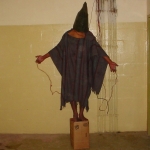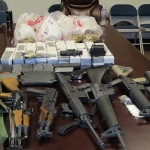Precision Farming: The Marriage Between Agribusiness and Spy Technology
Flipping the Genetically Modified Tortilla, or Turning the Biotech Critique on its Head
RELATED ARTICLES |
"Flip the tortilla" ("virar la tortilla") is a common Puerto Rican expression. It describes the act of taking someone's argument and turning it on its head. This is precisely what the biotechnology and agribusiness industries are now doing to confound their critics.
The corporations that brought us genetically modified (GM) crops fought a pitched battle against labeling and segregating their products from non-GM counterparts. Activists called for such measures because of concerns about the safety of genetically engineered foods.
Corporations countered that GM crops were perfectly safe, and that labeling and segregating them would be impractical and would create a cumbersome and prohibitively expensive regulatory apparatus.
Now, the GM corn tortilla is certainly being flipped as major biotech corporations begin to soften to activist demands to label and segregate GM crops. Far from being a sincere expression of corporate responsibility, critics say corporations are pushing for these measures in order to tighten their hold on farmers.
They charge that agribusiness hopes to extend its control over the food industry from the farm to the retail store. This unprecedented degree of corporate control will be made possible by a package of new surveillance technologies, which when put to agricultural use, are known as "precision farming."
Precision farming "benefits from the emergence and convergence of several technologies, including geographic information systems (GIS), automated machine guidance, infield and remote sensing, mobile computing, telecommunications and advanced information processing", according to GPS World magazine. The global positioning system (GPS) is a key technology used in precision farming that provides highly accurate geo-spatial information.
Which corporations are involved? Joining forces to promote precision farming are farm equipment manufacturers like John Deere, agrochemical companies like Monsanto and DowElanco, pharmaceutical/biotech companies like Rhone-Poulenc, Novartis and AstraZeneca, as well as information brokering/data management firms.
Not surprisingly, corporations with a long history of service to the military-industrial complex and intelligence agencies, like Rockwell and Lockheed Martin, are also jumping onto the precision farming bandwagon.
For example, in a 1,000-acre potato farm, aerospace behemoth Lockheed Martin can place meteorological stations that measure 13 different weather parameters every 15 minutes and telemeter the data to a computer base station.
"More than 430 gauges measure irrigation. Yield measurements are taken every three seconds during harvest. Crop quality samples are analyzed" Lockheed's promotional material boasts. What's more, "Soil is tested for 18 nutrient parameters Microbial communities in the topsoil are studied."
The Downside
An interesting historical parallel comes to mind. Just as World War Two military contractors developed the chemicals and machinery that fueled the Green Revolution of the 1970's, precision farming is, to a large extent, an outgrowth of the space-age surveillance technologies used in the Cold War. The tight relationship between the military industries and industrial agriculture continues well into the twenty first century.
Some observers fear that these new technologies bode ill for sustainable agriculture and democratic governance, and could impose new forms of dependence on farmers. "Precision farming has less to do with mitigating agricultural pollution than with advancing industrial modes of production", according to social scientists Steven Wolf of the University of California, Berkeley and Fred Buttel of the University of Wisconsin.
Action Group on Erosion, Technology and Concentration (ETC Group) Research Director Hope Shand agrees. "Precision farming is about commodification and control of information and it is among the high-tech tools that are driving the industrialization of agriculture, the loss of local farm knowledge and the erosion of farmers rights", she told CorpWatch.
"With precision farming, farmers increasingly depend on off-farm decision making to determine precise levels of inputs. For example, dictating what seed, fertilizer, chemicals, row spacing, irrigation and harvesting techniques are used, and other management requirements," Shand explained.
Precision farming seeks to legitimate and reinforce the uniformity and chemical-intensive requirements of industrial agriculture under the guise of protecting the environment and improving efficiency, according to Shand.
How it Works: Remote Sensing
Remote sensing is an important component of precision agriculture. For example, NASA is a partner in Ag 20/20, a long-range research project that involves remote sensing. A satellite-mounted sensor looks down on farm fields, distinguishing as many as 256 light wavelengths. Similar systems that work with land-based and plane-mounted sensors are also in the works.
With the right hardware, software and know-how, the precision farmer can use this spectral information to find out a crop's health status. Does it need irrigation? Is it under attack by pests? Are weeds gaining ground? Are soil nitrogen levels OK? A great number of quantifiable variables can be measured.
The use of satellites in agriculture is already a reality. The government of the southern Pacific island of Tasmania is using GPS technology on some 600 farms as part of an identity protection pilot program, which it plans to extend to all of Tasmania's farms by 2005. In Argentina, satellite surveillance is being used to catch farmers who cheat on their taxes by underreporting the size of their fields, and to prevent them from saving seed, which is illegal there.
Who Will Benefit?
Will farmers want, or be able, to understand the advanced gadgetry of precision farming? In Puerto Rico, for example, only 14% of farmers have college degrees, and a higher percentage might be illiterate altogether. The average Puerto Rican farmer is 55 years old, according to the US Farm Census. Many are probably too traditional to embrace advanced software, satellite imaging and other new technologies.
To get around this obstacle, precision farming contractors plan to offer farmers a plethora of consulting services. Critics fear that these services will exacerbate farmers' dependence on the purveyors of agribusiness even further.
Of course the more fundamental question is what farmer will be able to afford precision farming technology, whose basic packages start at $15,000 to $20,000? How can American family farms, facing extinction by economic strangulation, afford these dazzling technological advances?
What will happen to rural America and farming communities worldwide if food processors, retailers and other major purchasers of agricultural produce start requiring suppliers to use precision farming and identity protection technology? Large American industrial farms, heavily capitalized and subsidized by the US government with tens of billions of dollars a year, will easily afford the technology. But struggling family farms could be put out of business.
Suing the Victim
These remote sensing technologies can also be used to distinguish GM from non-GM crops, and trace genetic pollution. Runaway pollen and seeds from GM crops like soy, corn and canola have been a great concern since the commercial cultivation of GM plants began in 1996. Last year, GM corn was found to be aggressively proliferating in Mexico, causing farmers, scientists and environmentalists to worry about potential consequences for the environment, biodiversity and world agriculture.
Agribusiness corporations can use satellite imaging to find out what farmers have had their crops contaminated with GM pollen and sue them.
This actually happened to Canadian farmer Percy Schmeiser of Saskatchewan. When he complained that his organic canola crop had been genetically contaminated by a GM canola field somewhere upwind, Monsanto's lawyers sued him for illegally planting the corporation's patented seed. Kafka could have hardly thought of a more bizarre scenario.
Monsanto didn't accept Schmeiser's argument that the corporation's GM canola had blown downwind to his farm, and neither did the judge, who ruled that how the GM seed got there is irrelevant. In September 2002 Schmeiser lost his appeal and now intends to take his case to Canada's Supreme Court.
Unfortunately, Schmeiser's ordeal is not an isolated case. Monsanto is suing farmers all over Canada and the United States for allegedly planting its patented GM seeds without authorization. Many of them claim they never knowingly planted Monsanto's patented seeds, and that their fields were contaminated by upwind GM plantations.
Once again, the tortilla gets flipped. The same corporations that vehemently denied that GM pollution by pollination would ever take place, may soon be eager -- too eager-- to believe every report of such contamination. Especially if the information can be used to sue the victims.
Precision Agriculture and Global Trade
This type of persecution can reach global proportions through the Trade-Related Intellectual Property Rights agreement (TRIPs) enforced by the World Trade Organization (WTO). Under TRIPs, the WTO can impose economic sanctions against countries deemed guilty of illegally using patented products, like seeds. The intellectual property rights provisions of NAFTA are even more draconian, since the agreement allows private entities to sue governments.
Given this possibility, one can visualize a scenario in which Monsanto sues Mexico under NAFTA for illegally planting its GM corn. The corporation could conceivably demand a compensation ranging in the hundreds of millions of dollars.
What are advocates of socially responsible and environmentally sustainable agriculture doing about precision farming? Many in the movement against corporate globalization hold that this and other new agro-technologies, like biotech, must be addressed within the context of a broader critique of industrial agriculture.
"The reality is that farmers do not control precision farming," notes Hope Shand of ETC Group. "Rather, precision agriculture is more likely to dictate decision making, control and management of the farmer."
Shand compares precision agriculture to a kind of high tech feudalism: "Precision farming reinforces bioserfdom and the role of the farmer as a "renter of germplasm."
Carmelo Ruiz-Marrero is a Puerto Rican journalist. He is a Fellow at the Society of Environmental Journalists and a Research Associate at the Institute for Social Ecology.
- 9 Lockheed Martin
- 181 Food and Agriculture
- 192 Technology & Telecommunications



